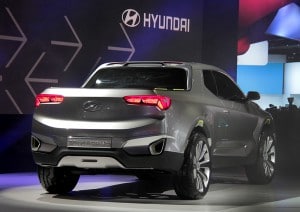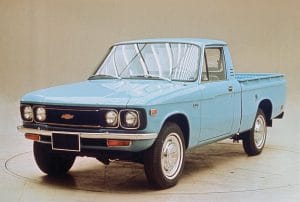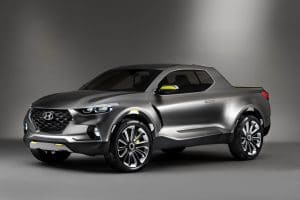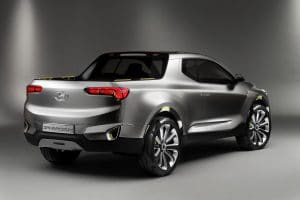After a lengthy wait, Hyundai has finally confirmed plans to produce the Santa Cruz pickup which, in concept form, was one of the stars of the 2015 North American International Auto Show in Detroit.
The compact truck will be produced at the automaker’s Montgomery, Alabama assembly plant – the facility set to undergo a $410 million expansion to handle the new vehicle. The project is expected to create 200 new jobs at the Hyundai plant and generate another 1,000 jobs in the region among automotive suppliers.
“Bringing the Santa Cruz to HMMA demonstrates that Hyundai Motor Company is confident our more than 3,000 Team Members are ready to build a quality crossover for the U.S. market,” said Byungjin Jin, president and CEO, Hyundai Motor Manufacturing Alabama.
(Exclusive: Hyundai Santa Cruz set for launch)
Hyundai insiders have told TheDetroitBureau.com that they hope to position the Santa Cruz as the modern-day equivalent of the classic, compact pickups that became an affordable, popular choice among then-young Baby Boomers in the 1970s and 1980s. While the Korean carmaker isn’t offering many official details, TheDetroitBureau.com has gleaned some critical points from company sources:
· The production version of the Santa Cruz will be smaller than any pickup currently available on the U.S. market;
· It will use a crossover platform, rather than a classic body-on-frame design;
· And while sources wouldn’t confirm whether it gets the bed extender found on the concept truck, the production Santa Cruz will feature “something different” with a tailgate meant to increase its functionality.
Hyundai officials were openly surprised by the strong reception the show car got in Detroit nearly five years ago and soon promised to work on a production model. Three years ago, former Hyundai CEO Dave Zuchowski told TheDetroitBureau.com the project was a “go,” something repeated by his successor a year later. But by early 2019, observers began to question if the project had run into a snag.
“We have so much on our plate (and) there were other priorities over the last several years,” such as mainstream models like the latest Santa Fe, a ranking Hyundai insider said on background Wednesday afternoon. “One of the big challenges was figuring out where we could build it.”

One key question is whether the production Santa Cruz will feature the bed extender shown on the 2015 concept truck.
Considering the U.S. was always expected to be a key market for the production Santa Cruz, the Alabama plant seemed a natural, but it has long struggled just to keep up with demand for existing models, such as the Santa Fe SUV, so Hyundai’s corporate management finally had to approve the $410 million expansion plan. Sources would not say whether that project will cover other models, new or existing, as well.
(Could Ford challenge the Hyundai Santa Cruz with a pickup smaller than the Ranger?)
As for the target audience, insiders stressed that Santa Cruz will not target existing small pickups, such as the Ford Ranger, Toyota Tacoma or new Jeep Gladiator. For one thing, it will be even smaller and have far less towing and cargo capacity. It will be positioned, said one source, as “more of a lifestyle, urban commuter vehicle,” than today’s pickups.
Mike O’Brien, Hyundai’s U.S. product planning chief, is fond of noting that a used Toyota Tacoma is one of the most popular vehicles on the market, particular among younger buyers. With Santa Cruz, Hyundai hopes to offer potential buyers a new vehicle alternative which would suggest a fairly low entry price.

Small trucks, like this old Chevy Luv, were wildly popular when Baby Boomers were just getting their drivers licenses.
The strategy appears to be aiming to reproduce the success automakers like General Motors, Ford and Toyota, among others, had in decades past when they offered stripped-down pickups that became the first new vehicle for many Baby Boomers.
If there is any direct comparison in the current market, it is the crossover-based Honda Ridgeline, though even that model is aimed more as a combination personal use and work truck.
But there could be other competitors over the next few years. With the successful revival of the midsize pickup segment, Ford has indicated it is working on a truck that would be even smaller than the current, midsize Ranger.
(Hyundai set to bring first pickup to market by 2021 … we wrote in 2017)
As to when the Hyundai Santa Cruz would come to market, that’s a detail the company is holding back, for now. But TheDetroitBureau.com has learned it could start to roll into showrooms in about 18 months, likely for the start of the 2022 model-year.



that’s great news. I am looking forward to buying one for myself. I am looking forward to more blogs like this.
Rather than the Chevy Luv, it appears to be more in line with the El Camino or Ford Ranchero.
Visually, yes, Jim, but the audience being targeted appears to be more like the tight-budget Boomers that loved the Luv.